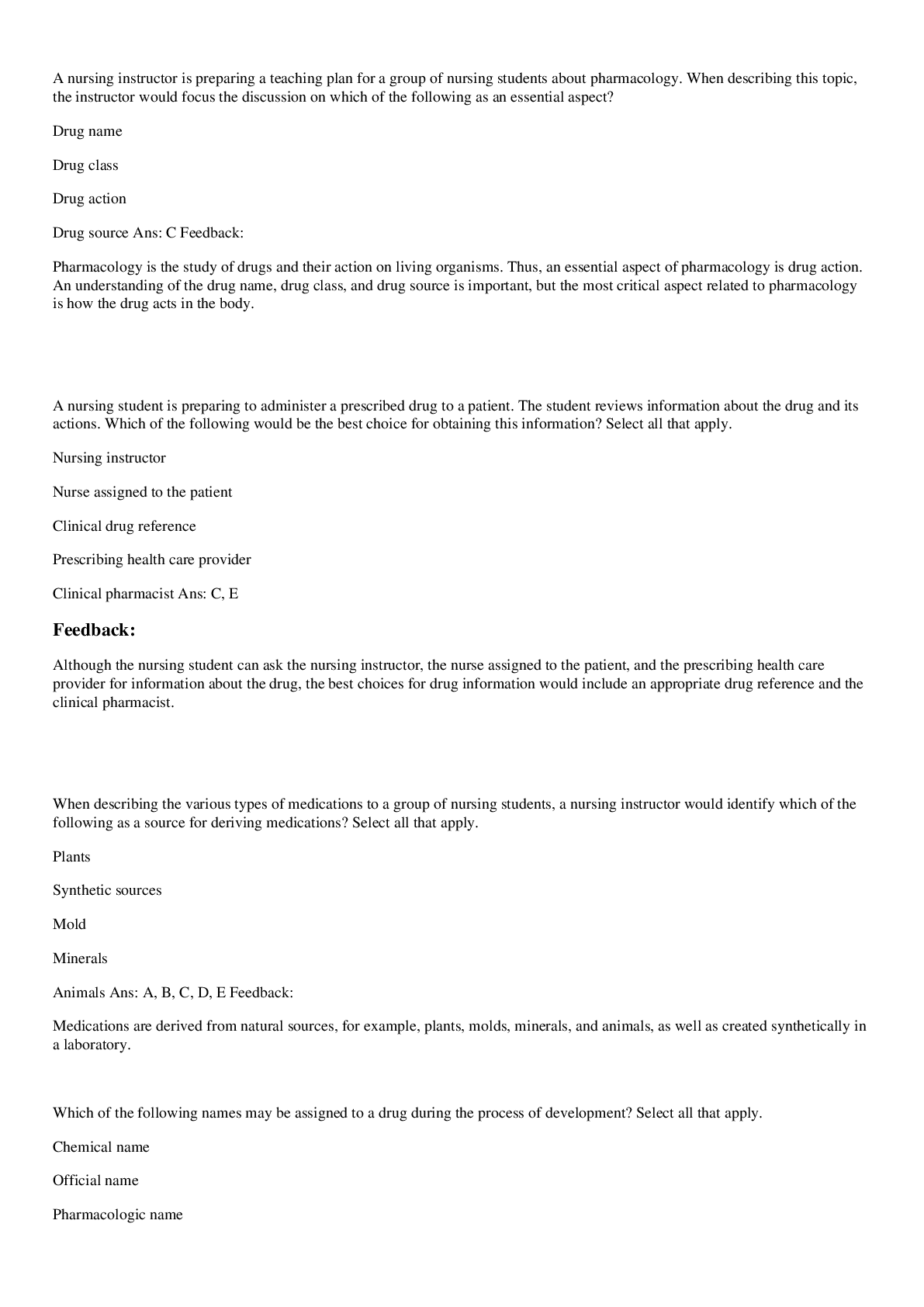Roach’s Introductory Clinical Pharmacology 11th edition By Ford
Document Content and Description Below
1. A nursing instructor is preparing a teaching plan for a group of nursing students about pharmacology. When describing this topic, the instructor would focus the discussion on which of the following... as an essential aspect? A) Drug name B) Drug class C) Drug action D) Drug source Ans: C Feedback: Pharmacology is the study of drugs and their action on living organisms. Thus, an essential aspect of pharmacology is drug action. An understanding of the drug name, drug class, and drug source is important, but the most critical aspect related to pharmacology is how the drug acts in the body. 2. A nursing student is preparing to administer a prescribed drug to a patient. The student reviews information about the drug and its actions. Which of the following would be the best choice for obtaining this information? Select all that apply. A) Nursing instructor B) Nurse assigned to the patient C) Clinical drug reference D) Prescribing health care provider E) Clinical pharmacist Ans: C, E Feedback: Although the nursing student can ask the nursing instructor, the nurse assigned to the patient, and the prescribing health care provider for information about the drug, the best choices for drug information would include an appropriate drug reference and the clinical pharmacist. 3. When describing the various types of medications to a group of nursing students, a nursing instructor would identify which of the following as a source for deriving medications? Select all that apply. A) Plants B) Synthetic sources C) Mold D) Minerals E) Animals Ans: A, B, C, D, E Feedback: Medications are derived from natural sources, for example, plants, molds, minerals, and animals, as well as created synthetically in a laboratory. 4. Which of the following names may be assigned to a drug during the process of development? Select all that apply. A) Chemical name B) Official name C) Pharmacologic name D) Trade name E) Nonproprietary name Ans: A, B, D, E Feedback: Throughout the process of development, drugs may have several names assigned to them including a chemical name, a generic (nonproprietary) name, an official name, and a trade or brand name. 5. A drug may be classified by which of the following? Select all that apply. A) The chemical type of the drug's active ingredient B) The way the drug is used to treat a specific condition C) The generic name of the drug D) The trade name of the drug E) The nonproprietary name of the drug Ans: A, B Feedback: A drug may be classified by the chemical type of the active ingredient or by the way it is used to treat a particular condition. Generic, trade, and nonproprietary refer to how a drug is named. 6. A group of nursing students are reviewing information about the process of drug development in the United States. The students demonstrate understanding of this process when they identify that which of the following categories are assigned by the Food and Drug Administration to newly approved drugs? Select all that apply. A) Metabolite B) Noncontrolled substance C) Prescription D) Nonprescription E) Controlled substance Ans: C, D, E Feedback: Once drugs are approved for use, the FDA assigns the drug to one of the following categories: prescription, nonprescription, or controlled substance. Metabolite refers to the inactive form of the drug. Noncontrolled substance is a term that is not used. 7. Which of the following would be most important for the nurse to do to ensure the safe use of prescription drugs in the institutional setting? Select all that apply. A) Administering drugs B) Monitoring clients for drug effects C) Prescribing drugs D) Evaluating clients for toxic effects E) Educating clients/caregivers about drugs Ans: A, B, D, E Feedback: In the institutional setting, the nurse's role to ensure safe use of prescription drugs includes administering drugs, monitoring drug effects, evaluating for toxic effects, and educating clients and caregivers about drugs. 8. The nurse is helping a client review a prescription from the health care provider. When examining the prescription, which of the following would the nurse expect to find documented? Select all that apply. A) Name of the drug B) Dosage of the drug C) Route of drug administration D) Times of drug administration E) Licensed prescriber's signature Ans: A, B, C, D, E Feedback: The prescription must contain the client's name, the name of the drug, the dosage, the method and times of administration, and the signature of the licensed health care provider prescribing the drug. 9. After teaching a group of nursing students about nonprescription drugs, the nursing instructor determines that the teaching was successful when the students identify which of the following? Select all that apply. A) They require a licensed health care provider's signature. B) They are referred to as over-the-counter drugs. C) They can be taken without risk to the client. D) They have certain labeling requirements. E) They should be taken only as directed on the label. Ans: B, D, E Feedback: Nonprescription drugs are often referred to as over-the-counter (OTC) drugs. They do not require a prescription (a licensed health care provider's signature) but do not come without risk to the client. The federal government has imposed labeling requirements of OTC drugs and they should only be taken as directed on the label unless under the supervision of a health care provider. 10. A nursing student is reviewing information about the Controlled Substances Act of 1970. The student would expect to find which of the following as being regulated for drugs classified as controlled substances? Select all that apply. A) Manufacturing B) Elimination C) Distribution D) Formulation E) Dispensing Ans: A, C, E Feedback: The Controlled Substances Act of 1970 regulates the manufacture, distribution, and dispensing of drugs classified as controlled substances. Elimination refers to the excretion of drugs from the body, a pharmacokinetic activity. The act does not address formulation of the drug. 11. When reviewing information about the Orphan Drug Program, which of the following would the nurse expect to find? Select all that apply. A) The program encourages the development and marketing of products to treat rare diseases. B) The program grants provisional approval with a written commitment from the drug company to formally demonstrate client benefits. C) The program provides for incentives, such as research grants, protocol assistance, and special tax credits, to develop products to treat rare diseases. D) The program grants 7 years of exclusive marketing rights to the manufacturer if approved. E) The program accelerates approval of drugs based on preliminary evidence before formal demonstration of client benefits. Ans: A, C, D Feedback: The Orphan Drug Program encourages the development and marketing of products used to treat rare diseases. The program provides incentives to encourage manufacturers to develop orphan drugs, and if approved, the manufacturer has 7 years of exclusive marketing rights. Accelerated programs involve provisional approval and approval based on preliminary evidence. 12. After teaching a group of nursing students about pharmacokinetics, the instructor determines that the teaching was successful when the students identify which of the following as a phase? Select all that apply. A) Absorption B) Distribution C) Administration D) Metabolism E) Excretion Ans: A, B, D, E Feedback: The pharmacokinetic phases are absorption, distribution, metabolism, and excretion. The acronym ADME is a helpful way to remember the pharmacokinetic phases. 13. A nurse is preparing a teaching plan for a client who is prescribed an oral medication. As part of the plan, the nurse expects to describe the importance of absorption. The nurse would integrate knowledge of which of the following as a mechanism for absorption in the gastrointestinal tract? Select all that apply. A) Active transport B) Transposition C) Passive transport D) Endocytosis E) Pinocytosis Ans: A, C, E Feedback: During absorption, the drug particles in the GI tract are moved into the body fluids via active transport, passive transport, and pinocytosis. 14. After teaching a group of nursing students about the half-life of a drug, the instructor determines the need for additional teaching when the students identify which of the following as true? Select all that apply: A) Half-life can be decreased in clients with renal disease. B) Half-life can help determine dosing frequency. C) Half-life does not change throughout a client's life. D) Liver disease can increase half-life. E) Half-life is the measure of the rate at which drugs are removed from the body. Ans: A, C Feedback: Half-life is the measure of the rate at which drugs are removed from the body, and any difficulty in excreting a drug increases half-life, including liver or kidney disease or advanced age. 15. A nurse is assessing a client after administering a prescribed medication. Which of the following would alert the nurse to suspect that the client is developing anaphylactic shock? Select all that apply. A) Bradycardia B) Hypertension C) Dyspnea D) Urticaria E) Angioedema Ans: C, D, E Feedback: The symptoms of anaphylactic shock are dyspnea, feeling of fullness in the throat, cough, wheezing, extremely low blood pressure, tachycardia (heart rate >100 bpm), palpitations, syncope, cardiac arrest, urticaria, angioedema, pruritus, sweating, nausea, vomiting, and abdominal pain. 16. Which of the following would the nurse identify as a factor that alters drug response in children and infants? Select all that apply. A) Slower gastric emptying B) Greater surface area C) Less protein binding D) Decreased body water content E) Less cutaneous fat Ans: A, B, C, E Feedback: Children and infants are not small adults; therefore, they have altered pharmacokinetics. Factors that alter pharmacokinetics in children include slower gastric emptying, less cutaneous fat, greater surface area, increased body water content, less protein binding, and immature hepatic and renal function. 17. The FDA established a safety information and adverse events reporting program called MedWatch. Which individuals can access the MedWatch website to obtain safety alerts on drugs, devices, or dietary supplements? Select all that apply. A) Physicians B) Nurses C) Patients D) Pharmacists E) Caregivers Ans: A, B, C, D, E Feedback: Anyone can access the MedWatch website to obtain safety alerts on drugs, devices, or dietary supplements. 18. A nurse is preparing to administer a prescribed medication to a client. The nurse integrates knowledge of which of the following as a possible factor that could influence the drug response? Select all that apply. A) Age B) Polypharmacy C) Weight D) Sex E) Disease Ans: A, B, C, D, E Feedback: Drug response can be influenced by the following factors: age, polypharmacy, weight, sex, disease, and genetics. 19. A nurse is assessing a client and notes that the client has developed swelling of the eyelids and lips after administration of a prescribed medication. The nurse interprets this finding as specifically indicating which of the following? A) Mild allergic reaction B) Anaphylactic shock C) Angioedema D) Drug idiosyncrasy Ans: C Feedback: Angioedema is a type of allergic drug reaction manifested by the collection of fluid in the subcutaneous tissues, most commonly affecting the eyelids, lips, mouth, and throat. Allergic reactions can be manifested by a wide range of signs and symptoms such as itching, rashes, and hives. Anaphylactic shock is a serious allergic reaction that requires immediate medical attention. Drug idiosyncrasy describes any unusual or abnormal reaction to a drug, one that is different from the one normally expected. 20. Which of the following is true regarding the Dietary Supplement Health and Education Act (DSHEA)? Select all that apply. A) The act allows for DEA enforcement of the act. B) The act gives the FDA power to enforce the laws governed by the act. C) The act permits general health claims. D) The act permits curative health claims. E) The act defines specific substances as “dietary supplements.” Ans: B, C, E Feedback: The DSHEA defines substances such as herbs, vitamins, minerals, amino acids, and other natural substances as “dietary supplements” and permits general health claims as long as the label also has a disclaimer stating that the supplements are not approved by the FDA and are not intended to diagnose, treat, cure, or prevent any disease. The act gives the FDA the power to enforce the laws governed by the act. 21. When reviewing the phases of drug development, the nurse finds a discussion about the postmarketing surveillance phase. Which one of the following activities would the nurse expect to find as being carried out during this phase? A) Health care providers report adverse effects to FDA. B) Healthy volunteers are involved in the test. C) In vitro tests are performed using human cells. D) The drug is given to patients with the disease. Ans: A Feedback: The postmarketing surveillance phase of drug development encourages health care professionals to report adverse effects of drugs to the FDA using MedWatch. Phase 1 of clinical testing involves 20 to 100 healthy volunteers. In vitro testing of the drug on human or animal cells is done in the pre-FDA phase. In Phase 2 of clinical testing, the drug is given to patients with the disease for which the drug is manufactured. 22. A nurse is assessing a pregnant client and learns that the client is addicted to cocaine. The nurse informs the client about the risks of cocaine addiction for her fetus. Which of the following would the nurse include? A) The child may be born with diabetes. B) The child may be born with hypertension. C) The child may be born with an addiction to drugs. D) The child may be born with CNS defects. Ans: C Feedback: The nurse informs the client that children born to mothers using addictive drugs are often born with an addiction to the drug. Children born to mothers who are addicted to cocaine are not known to be born with diabetes, CNS defects, or hypertension. 23. A patient arrives at the health care clinic and informs the nurse that he has consumed several aspirin tablets for a severe headache over the past 24 hours. The nurse would be alert for which of the following as a harmful effect? A) Gastrointestinal bleeding B) Breathing difficulties C) Visual disturbances D) Loss of balance Ans: A Feedback: Aspirin is potentially harmful and can cause gastrointestinal bleeding and salicylism. Breathing difficulties, visual disturbances, and loss of balance could be due to an illness or the effects of some other drug. 24. The nurse observes that after administration of a drug the patient has developed itching and a skin rash. The nurse interprets these findings as which of the following? A) Toxicity B) Allergic reaction C) Angioedema D) Crystalluria Ans: B Feedback: Allergic reactions are manifested by a variety of signs and symptoms including itching, skin rashes, and hives. Swollen eyelids, lips, and mouth are some of the symptoms of angioedema, an allergic drug reaction that may block the airway, causing asphyxia. Toxicity or toxic reactions are caused when blood concentration levels exceed the therapeutic level of drugs. Reduced blood pressure is called hypotension. Crystals in the urine are symptoms of crystalluria. 25. A patient is receiving digoxin as treatment for heart failure. Which of the following would be most important for the nurse to monitor to reduce the risk for toxicity? A) Seizure activity B) Drug blood level C) Urinary output D) Blood pressure Ans: B Feedback: The nurse should monitor the patient's blood level of the drug to ensure that the level remains within the therapeutic range. Monitoring seizure activity, urination frequency, and blood pressure will not prevent toxicity. Seizure activity is unrelated to digoxin or heart failure. 26. A patient has been using sleeping pills every night for the past several months. Now admitted to the hospital, he is prescribed his usual dose of sleeping pill. After administration, the patient continues to be restless and is wide awake. The nurse notifies the health care provider, who prescribes an increased dose. After receiving the new dose, the patient falls asleep. The nurse interprets this as which of the following? A) Drug idiosyncrasy B) Cumulative drug effect C) Drug tolerance D) Toxic reactions Ans: C Feedback: The patient has developed drug tolerance and has to be administered an increased dosage of the drug to achieve the desired effect. Cumulative drug effect occurs when the body is unable to metabolize and excrete one (normal) dose of a drug before the next dose is given. Drug idiosyncrasy is a term used to describe any unusual or abnormal reaction to a drug. Toxic reactions are caused when blood concentration levels exceed the therapeutic levels of a drug. 27. A patient wants to know about the possible interactions of the various drugs that he has been prescribed for an illness. The nurse explains that the drugs interact with each other and produce an effect that is greater than the sum of their separate actions. Which of the following reactions is the nurse informing about? A) Additive drug reaction B) Synergistic drug reaction C) Antagonistic drug reaction D) Toxic drug reaction Ans: B Feedback: A synergistic drug reaction occurs when drugs interact with each other and produce a sum greater than the sum of their separate actions. An additive drug reaction occurs when the combined effect of two drugs is equal to the sum of each drug given alone. An antagonistic drug reaction occurs when one drug interferes with the action of another, causing neutralization or a decrease in the effect of one drug. Toxic drug reactions are caused when blood concentration levels exceed the therapeutic levels of a drug. 28. A nurse has administered drugs to a patient as per the physician's orders. Which of the following activities should the nurse perform after administering the prescribed drugs to the patient? A) Record symptoms of the condition. B) Perform a culture and sensitivity test. C) Obtain history of drug allergy. D) Check for adverse drug reactions. Ans: D Feedback: After administering the drug to the patient, the nurse should observe the patient for adverse drug reactions. Recording symptoms of infection, performing a culture and sensitivity test, and obtaining a history of drug allergy are typically performed by the nurse in the preadministration assessment stage. 29. The nurse administers a prescribed medication that is supplied as an enteric-coated tablet. The patient asks the nurse about this form of tablet. When describing how this tablet is absorbed, which response by the nurse would be most accurate? A) “The medication dissolves directly from the stomach into the body.” B) “The drug breaks up into pieces as it moves through the stomach.” C) “The medication bypasses the GI tract and goes quickly into the bloodstream.” D) “The drug dissolves into fragments after it reaches your small intestine.” Ans: D Feedback: Enteric-coated tablets disintegrate or fragment after reaching the alkaline medium of the small intestine. Tablets and capsules break up into small particles and dissolve into body fluids in the gastrointestinal tract. Liquids and parenteral drugs are quickly absorbed into the body system. 30. After teaching a group of nursing students about pharmacokinetics, the instructor determines that the teaching was successful when the students identify which of the following as the first phase? A) Metabolism B) Absorption C) Distribution D) Excretion Ans: B Feedback: Pharmacokinetics refers to the transportation activity of drugs in the body after administration. The first component is absorption. This is followed by distribution, metabolism, and finally excretion. 31. A patient is considering using herbal supplements and asks the nurse about them. Which response by the nurse would be most appropriate? A) “Herbal supplements are safe to use because they are regulated closely.” B) “Herbal supplements can affect the way other medications will act.” C) “Taking more than the recommended amount usually is not harmful because they are natural.” D) “The risk of the supplement interacting with any prescription medications is extremely low.” Ans: B Feedback: The nurse needs to explain to the patient that just because an herbal supplement is labeled “natural” does not mean the supplement is safe or without harmful effects. Herbal supplements can act the same way as drugs and can cause medical problems if not used correctly or if taken in large amounts. Herbal supplements are not regulated by the FDA, so products lack standardization in relation to purity and potency. In addition, the patient should be warned not to take more than the recommended dose of any herbal health product or supplement. The problems that these products can cause are much more likely to occur if the patient takes too much or takes them for too long. 32. A nurse is reading a journal article about seasonal allergies and comes across the name of the drug loratadine. The nurse identifies this drug name as which of the following? A) Chemical B) Generic C) Trade D) Brand Ans: B Feedback: The generic name is the name given to a drug that can be made or marketed by any company and is the name given to the drug by the FDA. The chemical name is the scientific term that describes the molecular structure of the drugs, typically the chemical components. The trade or brand name of the drug is the name selected by a specific company for marketing purposes and is followed by a trademark symbol or registered trademark symbol. 33. A group of nursing students are reviewing information about drug development in the United States in preparation for an exam. The students demonstrate understanding of this material when they identify testing of which of the following as one of the first steps? A) Small group of healthy volunteers B) People who have the disease C) Live animals D) Large numbers of patients Ans: C Feedback: Initially, drug testing begins with testing in an artificial environment such as a test tube, and then this testing is followed by testing on live animals. Next, clinical testing occurs with each phase involving a larger number of people. First, a small group of 20 to 100 healthy volunteers are tested; then testing is performed on people who have the disease or condition. Last, the drug is given to large numbers of patients in medical research centers. 34. After teaching a group of nursing students about pharmacokinetics, the instructor determines that the teaching was successful when the students identify which of the following as the site for the metabolism of most drugs? A) Liver B) Lungs C) Kidneys D) Intestinal mucosa Ans: A Feedback: Although the kidneys, lungs, plasma, and intestinal mucosa may aid in the metabolism of drugs, most drugs are metabolized by the liver. [Show More]
Last updated: 1 year ago
Preview 1 out of 86 pages
Instant download

Buy this document to get the full access instantly
Instant Download Access after purchase
Add to cartInstant download
Reviews( 0 )
Document information
Connected school, study & course
About the document
Uploaded On
Sep 10, 2021
Number of pages
86
Written in
Additional information
This document has been written for:
Uploaded
Sep 10, 2021
Downloads
0
Views
33

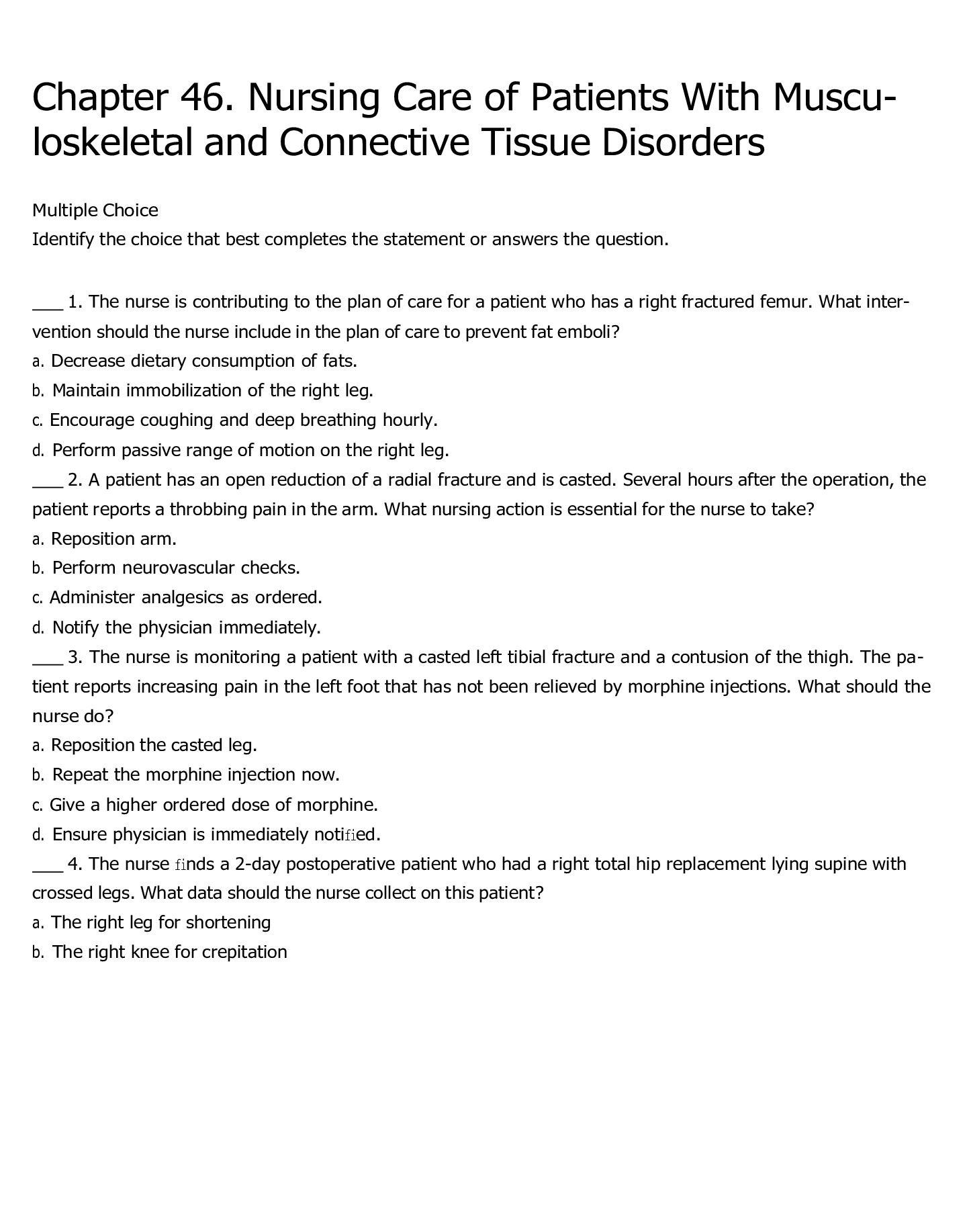
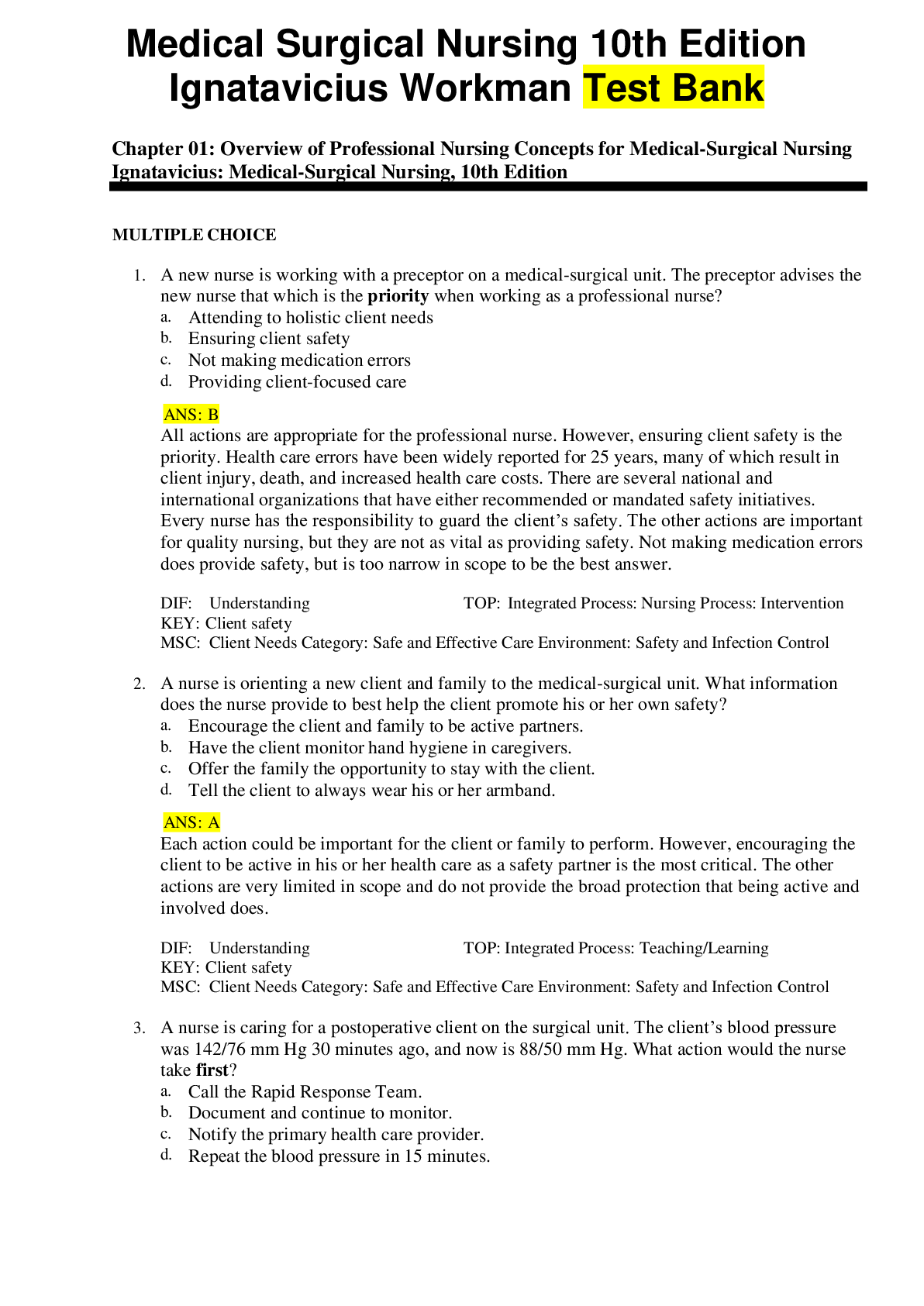
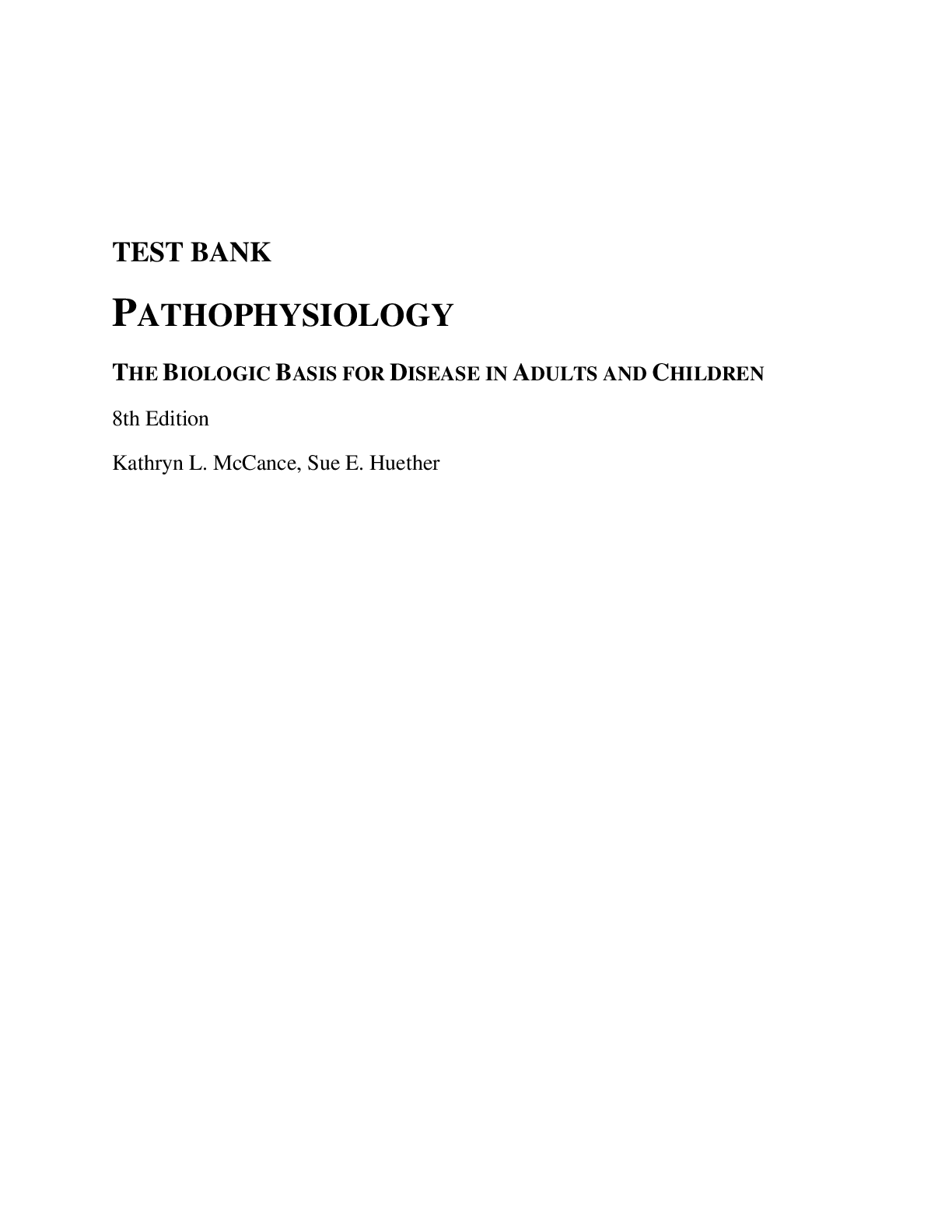



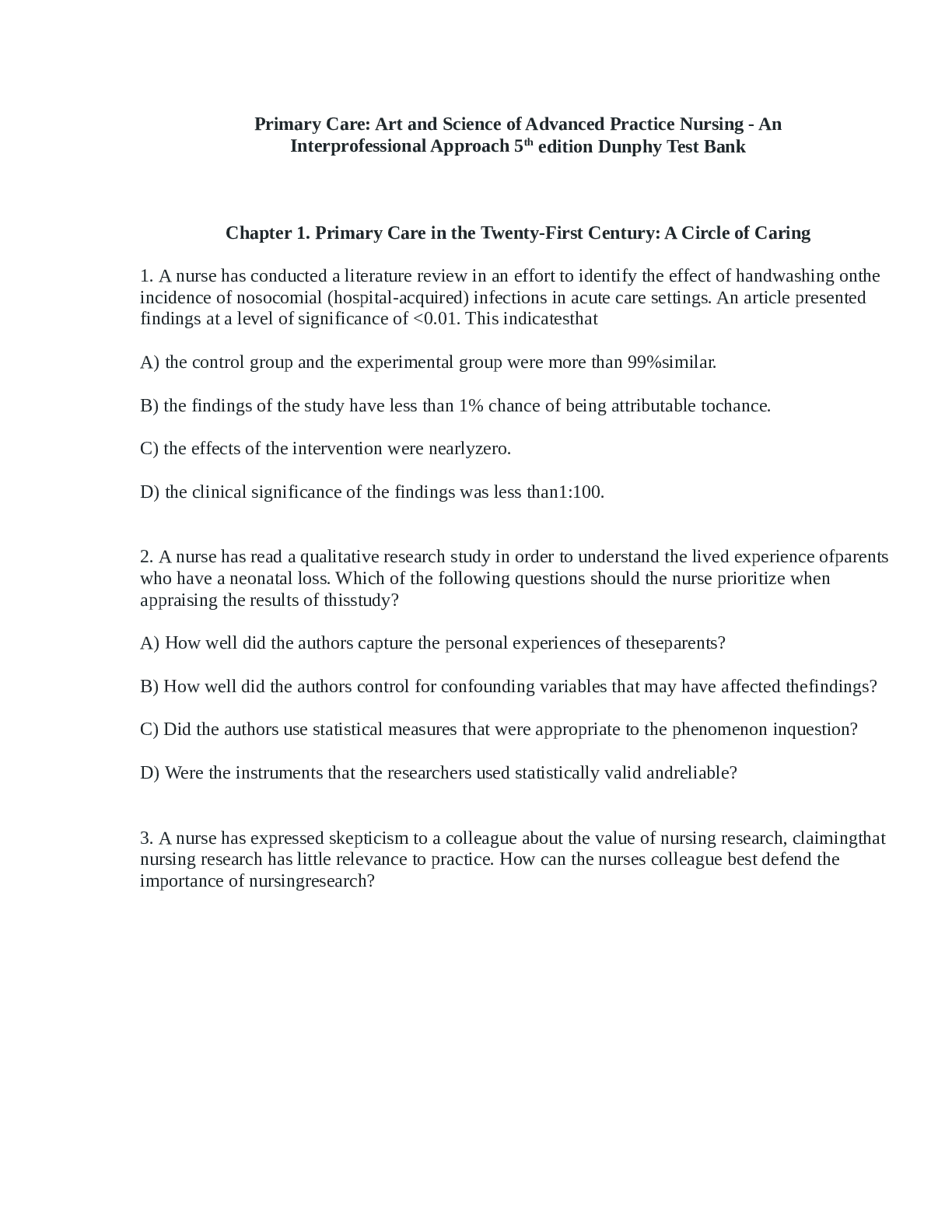




.png)

